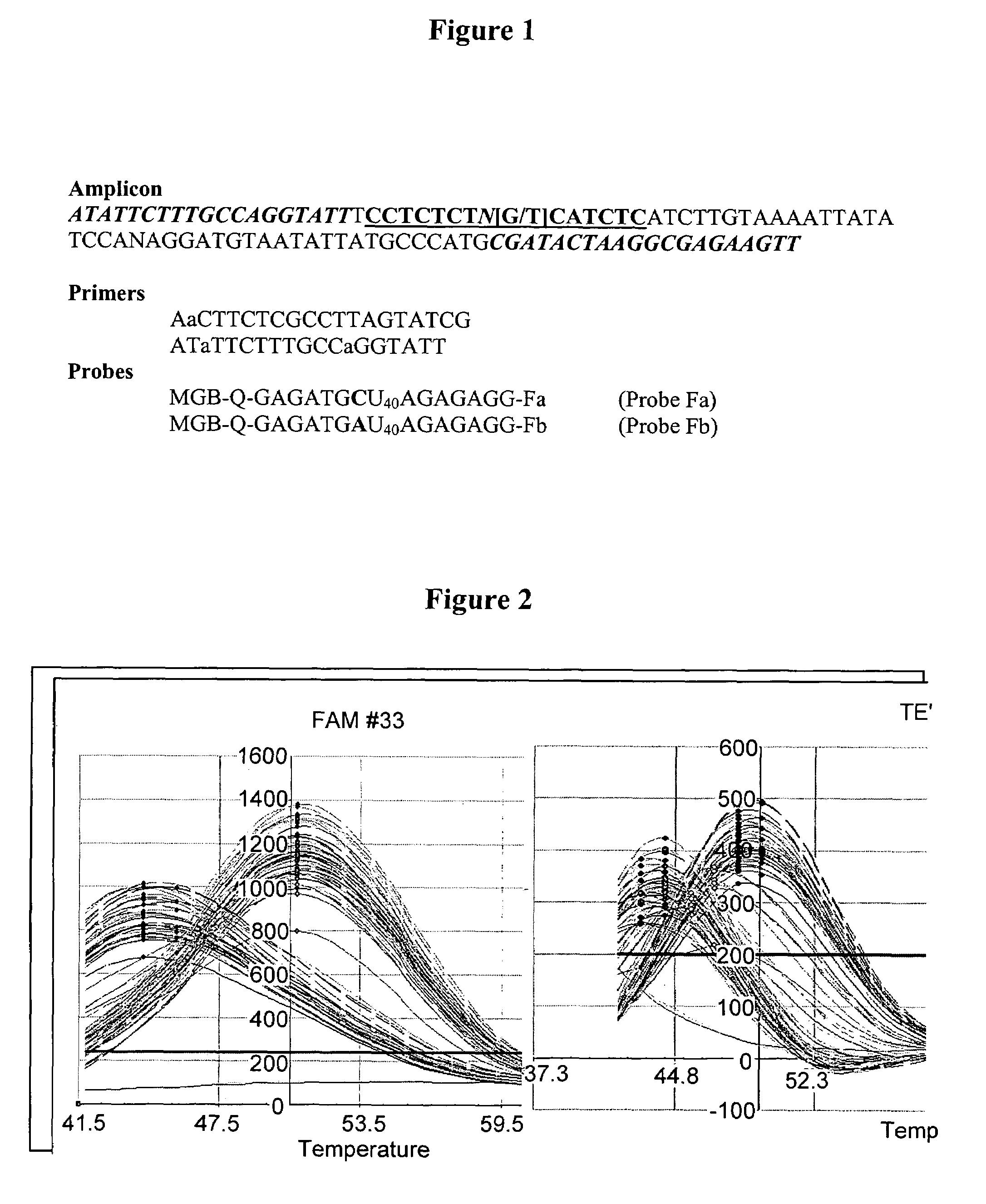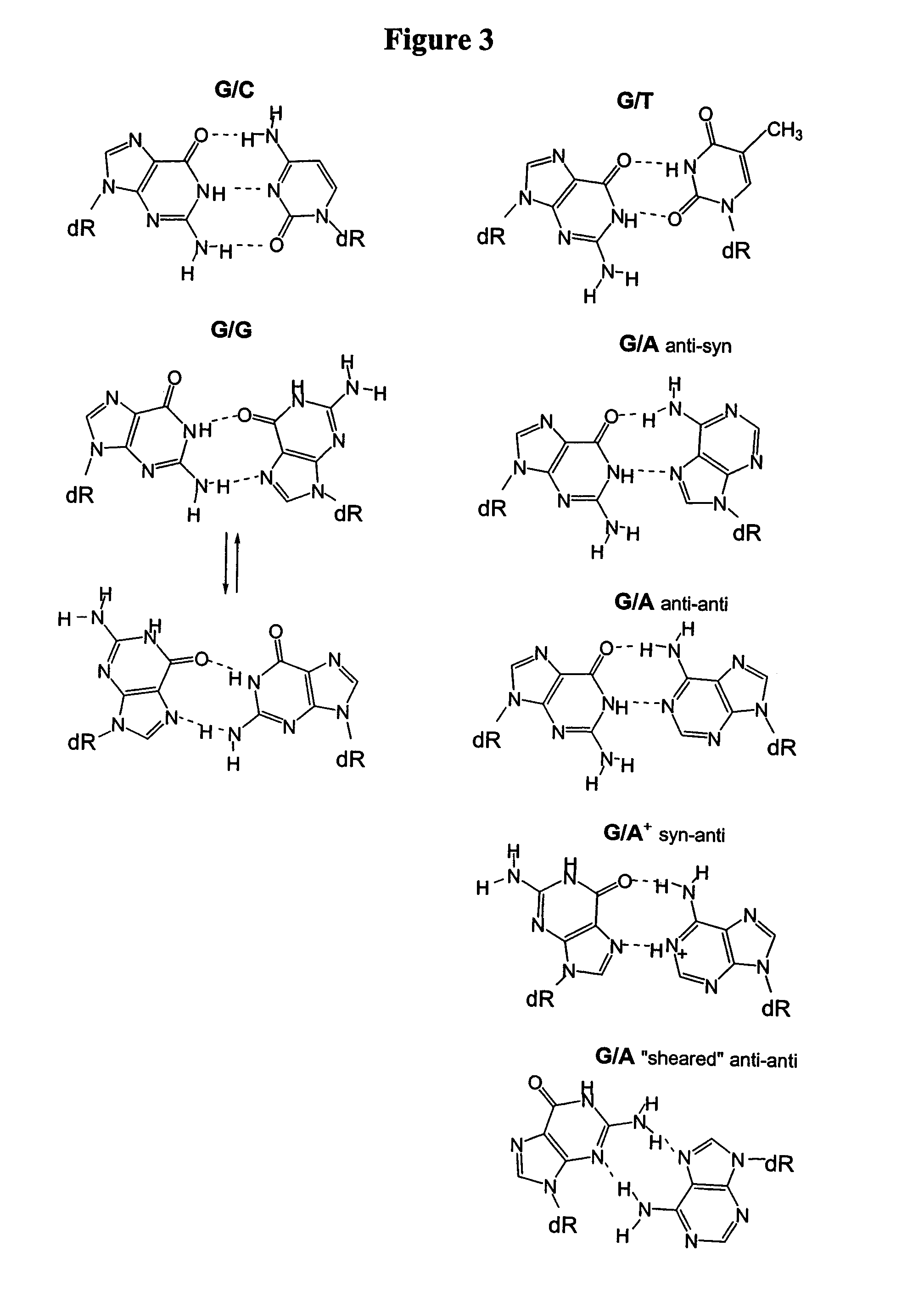Single nucleotide polymorphism analysis of highly polymorphic target sequences
a single nucleotide polymorphism and target sequence technology, applied in the field of single nucleotide polymorphism analysis of highly polymorphic target sequences, can solve the problems of complex genotyping, difficult if not impossible detection of many snp detection methods, and difficulty in genotyping a polymorphism by snp detection methods
- Summary
- Abstract
- Description
- Claims
- Application Information
AI Technical Summary
Benefits of technology
Problems solved by technology
Method used
Image
Examples
example 1
[0179]This example demonstrates that a polymorphism can be genotyped in the presence of a second polymorphism in close proximity of the allele of interest, by substitution with a universal base in the probe position involved in second polymorphism. Generally, genotyping of a double polymorphism with single probe by traditional melting curve analysis has provided results that are inconclusive. Use the methods below provide a more accurate genotyping than has previously been achieved.
Materials and Methods
1.1 Templates
[0180]Human genomic DNAs were purchased from Coriell Institute of Medical Research, Camden, N.Y. Genotyping was previously done in our laboratory using restriction length polymorphism and TaqMan methods.
1.2 Oligonucleotides
[0181]Sequences of oligonucleotides used are shown in FIG. 1. Primers were synthesized using standard phosphoramidite chemistry. The 5′-MGB-Q Eclipse probes were prepared by automated DNA synthesis on a MGB-Q-modified glass support (MGB™ ligand is DPI3 ...
example 2
[0186]This example illustrates the evaluation of nitroindole (13) and nitropyrrole (9) as universal based in a model system. Eight targets were prepared to evaluate a probe with a polymorphism of interest in the presence of two additional polymorphisms in the probe sequence region. The probe and target sequences are shown in Table 4.
[0187]
TABLE 4Probe and target sequences to evaluate the basepair characteristics of nitroindole (13) andnitropyrole (9).Probe Sequence3′-CTTCTC GATTCC AG-Q-MGB-5′ (SEQ ID NO:8)Tm ° C. DuplexTargetTarget SequenceNitroindoleNitropyrrole#5′→3′(13)(9)1TTC CTA GGA ATC GGA50.344.3GAA G(SEQ ID NO:9)2TTC CTT GGA ATC GGA52.244.9GAA G(SEQ ID NO:10)3TTC CTC GGA ATC GGA56.148GAA G(SEQ ID NO:11)4TTC CTG GGA ATC GGA53.145.1GAA G(SEQ ID NO:12)5TTC CTA GGA ATC AGA51.347.6GAA G(SEQ ID NO:13)6TTC CTT GGA ATC AGA51.348GAA G(SEQ ID NO:14)7TTC CTC GGA ATC AGA55.850.4GAA G(SEQ ID NO:15)8TTC CTG GGA ATC AGA52.747.6GAA G(SEQ ID NO:16)N1 base evaluates the ability to hybridize t...
example 3
[0189]This example describes the determination of the melting temperature of a probe:target duplex.
[0190]Thermodynamic parameters of duplex formation were derived by the Van't Hoff analysis methods. The shape of each melting curve was fitted to the two-state model with linear base lines (Xia, T. et al., Biochem., 37, 14719-14735 (1998)) using a nonlinear least-square program (Lokhov, S. G. and Pyshnyi, D. V., FEBS 420, 134-138 1997)). Unless otherwise stated, Tm of DNA duplexes were measured in 1×PCR buffer at a concentration of 5×10−7 M as described earlier (Kutyavin, I. V. et al., Nucleic Acids Res., 28, 655-661 (2000)).
PUM
| Property | Measurement | Unit |
|---|---|---|
| emission wavelengths | aaaaa | aaaaa |
| melting temperatures | aaaaa | aaaaa |
| Tm | aaaaa | aaaaa |
Abstract
Description
Claims
Application Information
 Login to View More
Login to View More - R&D
- Intellectual Property
- Life Sciences
- Materials
- Tech Scout
- Unparalleled Data Quality
- Higher Quality Content
- 60% Fewer Hallucinations
Browse by: Latest US Patents, China's latest patents, Technical Efficacy Thesaurus, Application Domain, Technology Topic, Popular Technical Reports.
© 2025 PatSnap. All rights reserved.Legal|Privacy policy|Modern Slavery Act Transparency Statement|Sitemap|About US| Contact US: help@patsnap.com



